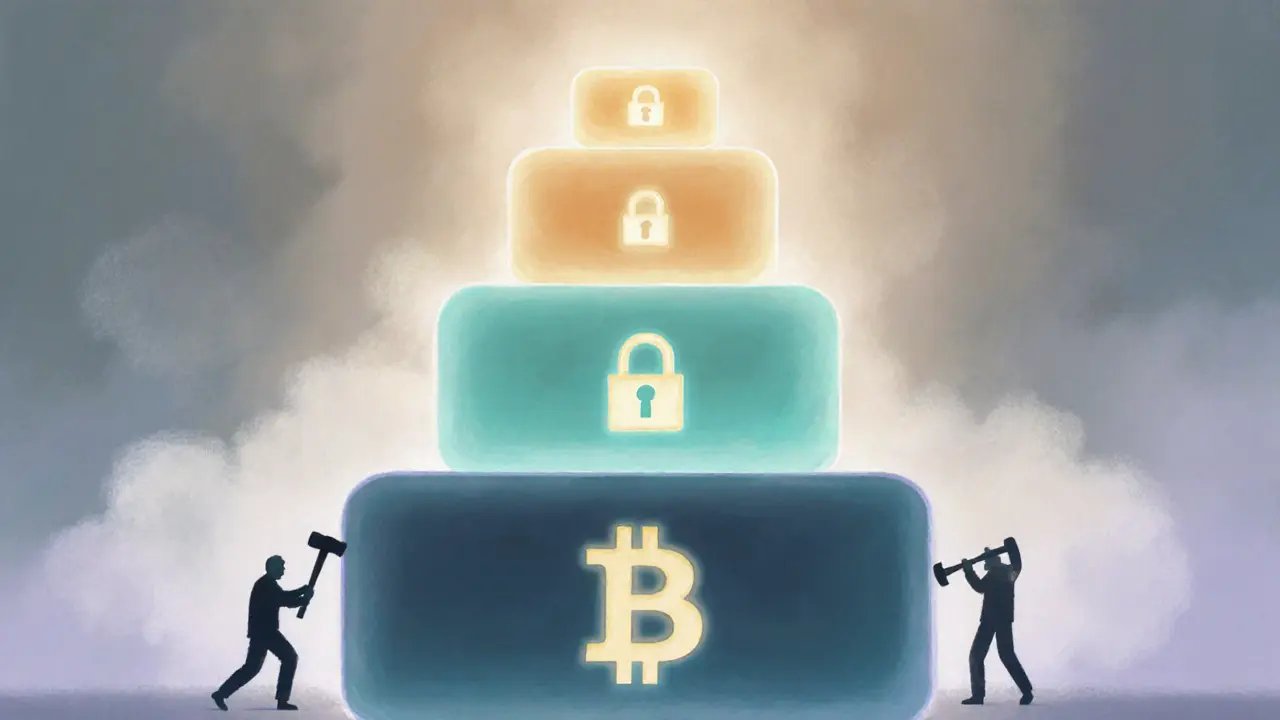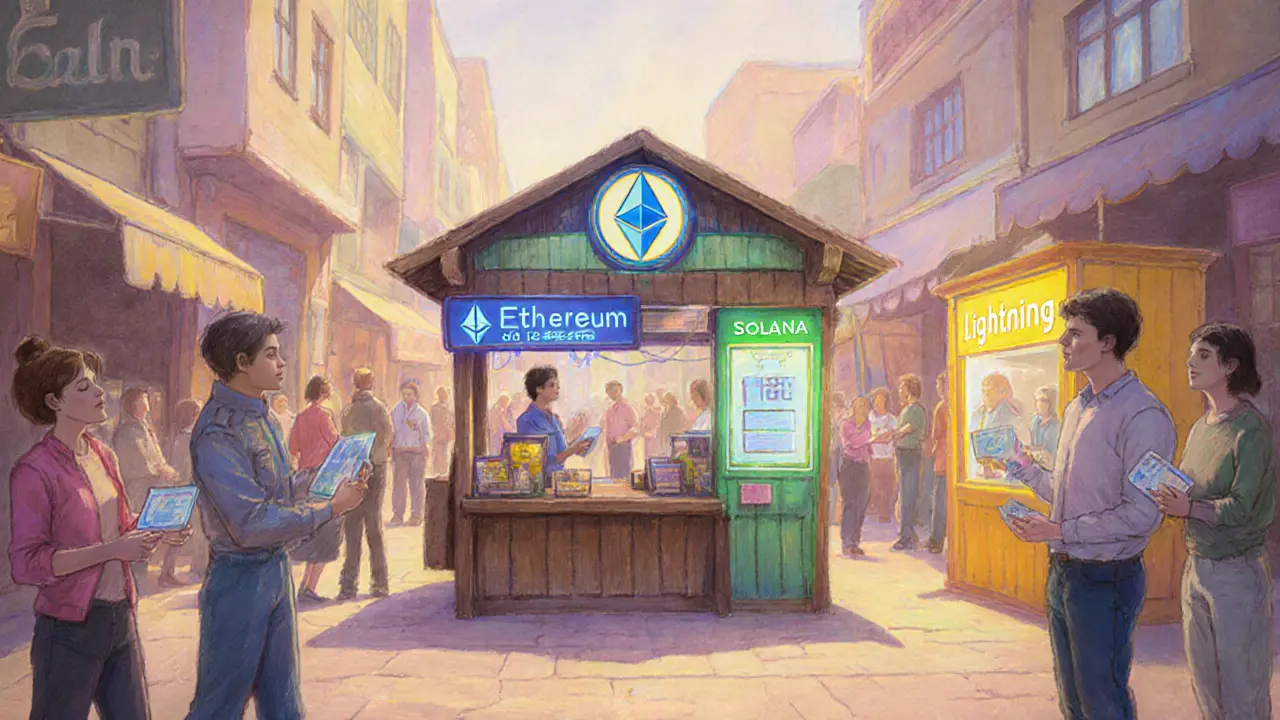How Confirmation Time Stops Double-Spends in Blockchain

Blockchain Confirmation Security Calculator
Security Analysis
Estimated Security Level:
Recommended Use Case:
Key Takeaways
- Confirmation time is the interval from broadcast to permanent block inclusion.
- Each additional block exponentially raises the cost of a double‑spend attack.
- Bitcoin, Ethereum, and Solana use different block intervals and finality models.
- Fee markets, RBF, and layer‑2 solutions let users trade speed for security.
- Merchants should match confirmation thresholds to transaction value and risk appetite.
When you send crypto, the moment the network sees your transaction isn’t the moment it’s safe. The confirmation time is the window where a malicious actor could try to spend the same coins twice. Understanding how that window works-and how each blockchain shrinks or widens it-lets you decide when a payment is truly final.
What is Confirmation Time?
Confirmation time is the period between a transaction’s initial broadcast to the network and the point where it is recorded in a validated block that becomes part of the canonical chain. In practice, it covers several sub‑steps: propagation to peers, storage in the mempool, selection by miners or validators, cryptographic verification, and finally block inclusion. The longer a transaction sits in the mempool, the more exposure it has to double‑spend attempts.
Why Confirmation Time Matters for Double‑Spend Prevention
A double‑spend occurs when an attacker tricks the network into accepting two conflicting transactions that spend the same inputs. The primary defense is the longest‑chain rule: the chain with the most accumulated work (or stake) is considered canonical. Each new block that builds on top of a transaction adds another layer of proof that the attacker would need to overwrite.
With a single confirmation, an attacker needs to replace just one block-a modest effort on a low‑hash‑rate network. Six confirmations on Bitcoin, however, mean rewriting six consecutive blocks, which would require over 51% of the network’s hash power and massive electricity costs. The probability of a successful reversal drops exponentially with each added block, giving users a quantifiable confidence level.
Phases of Confirmation in Detail
- Broadcast: Your wallet sends the signed transaction to a handful of peers.
- Propagation: Peers relay the transaction across the network, filling the mempool of each node.
- Selection: Miners (PoW) or validators (PoS) pick pending transactions based on fee, age, and policy.
- Verification: The chosen node checks signatures, nonce, and that inputs are still unspent.
- Block Inclusion: The transaction is packed into a new block and broadcast.
- Finality: Subsequent blocks are added on top, each confirming the previous one.
The total wall‑clock time varies widely across chains because block intervals differ and congestion can delay any of the steps.

How Major Blockchains Treat Confirmation Time
Below is a quick comparison of the most popular networks. The numbers reflect average values in 2025 and include the typical number of confirmations that exchanges or merchants require for medium‑value transfers.
| Network | Block time | Typical confirmations needed | Effective security (approx.) | Notable double‑spend defense |
|---|---|---|---|---|
| Bitcoin | 10 minutes | 1‑6 (high‑value: 6) | 51% hash‑power required to rewrite 6 blocks | Proof‑of‑Work longest‑chain rule |
| Ethereum | 12 seconds (PoS slots) | 1‑2 (large exchanges: 30) | Validator slashing + >30 confirmations for high‑value | Proof‑of‑Stake validator committee |
| Solana | 0.4 seconds | 1‑3 | Small validator set; economic penalties | Proof‑of‑History + PoS hybrid |
| Lightning Network | Instant (off‑chain) | 0 (pre‑funded channels) | Smart contract escrow; dispute window | Multi‑signature channel contracts |
Notice how faster block times generally lower the number of confirmations needed, but they also rely on different economic guarantees. Solana’s sub‑second blocks are safe only because a relatively small, well‑bonded validator set backs them. Bitcoin’s slower 10‑minute blocks demand more confirmations for the same security level.
Tools to Shrink Confirmation Time Without Sacrificing Security
Most users can influence how quickly their transaction lands in a block by adjusting fees. Bitcoin’s replace‑by‑fee (RBF) lets you bump the fee after broadcasting, speeding up inclusion during congestion. Ethereum’s EIP‑1559 fee market separates a predictable base fee from an optional priority tip, giving you fine‑grained control.
Advanced wallets also run prediction models that analyze current mempool depth, recent block times, and fee history to suggest the optimal fee for a target confirmation window. For high‑value transfers, many traders opt for “fee‑bumping” services that automatically replace the transaction if the first attempt lags.
Security Trade‑offs: Speed vs. Decentralization
Every consensus algorithm balances three forces-security, scalability, and decentralization-often called the blockchain trilemma. Proof‑of‑Work (Proof‑of‑Work) offers strong security at the cost of slower blocks and high energy usage. Proof‑of‑Stake (Proof‑of‑Stake) speeds up finality but requires validators to lock up capital, creating a different economic attack surface.
Deterministic finality protocols like Tendermint (used by Cosmos) provide instant finality-once a block is committed, it cannot be rolled back. The trade‑off is a smaller, permissioned validator set, which can be less decentralized than Bitcoin’s open‑mining pool.
Choosing the right network therefore depends on the use case: retail payments can tolerate a few seconds of risk, while large institution transfers demand hours of cumulative confirmations.
Practical Guidelines for Users and Merchants
- Low‑value, low‑risk purchases (< $1,000): Accept zero‑confirmation or 1‑confirmation payments on a fast network like Ethereum or Lightning.
- Medium‑value transactions ($1,000‑$10,000): Require 2‑3 confirmations on Bitcoin or 1‑2 on Ethereum, adjusting upward if the network is congested.
- High‑value deposits (>$10,000): Follow exchange standards-6 confirmations on Bitcoin, 30+ on Ethereum, or wait for a full epoch on PoS chains.
- Time‑critical services: Use layer‑2 solutions (Lightning, Optimism) that settle instantly while still leveraging the main chain’s security.
Always monitor the mempool and fee market before sending a large sum. A modest fee increase can cut confirmation time from an hour to under ten minutes on Bitcoin during normal load.
Future Directions: Faster, Safer Finality
Research is racing ahead to make confirmation both instant and secure. Sharding proposals on Ethereum aim to keep the same security guarantees while reducing the number of validators needed per shard, effectively shortening the time to finality. Cross‑chain bridges with atomic swaps are experimenting with cryptographic proof‑of‑receipt that lets users move assets without waiting for multiple confirmations on both chains.
Quantum‑resistant signatures could eventually change the maths behind block validation, but the core principle will stay the same: each new block adds an irreversible layer that makes double‑spending exponentially harder.

Frequently Asked Questions
How many confirmations are enough for a Bitcoin payment?
For most retail purchases, 1‑3 confirmations (10‑30 minutes) provide a good balance. Exchanges and high‑value transfers usually wait for 6 confirmations, roughly an hour, to protect against a 51% attack.
Can I avoid waiting for confirmations on Ethereum?
Yes, by using layer‑2 rollups (Optimism, Arbitrum) or the Lightning‑style State Channels. These settle instantly while the underlying chain provides dispute resolution if something goes wrong.
What is replace‑by‑fee (RBF) and when should I use it?
RBF lets you broadcast a new transaction with a higher fee that supersedes the original one still sitting in the mempool. Use it when you notice network congestion after sending a transaction and you need it confirmed faster.
Why does a faster block time sometimes mean lower security?
Faster block times often rely on a smaller validator set or lighter proof mechanisms, which reduces the economic cost for an attacker to control a majority. Bitcoin’s ten‑minute blocks give the network more time to absorb hash power, making attacks costlier.
Is zero‑confirmation safe for small payments?
For amounts under a few hundred dollars, many merchants accept zero‑confirmation because the potential loss is outweighed by the better user experience. They usually employ real‑time monitoring to spot any double‑spend attempts before the transaction settles.








Block confirmations are just a marketing gimmick, they dont actually stop double‑spends, u just pay extra time for nada.
From a technical perspective the latency introduced by additional confirmations directly correlates with the security parameter α within the underlying consensus algorithm
When you look at the mechanics of a blockchain you’ll notice that each new block adds a cryptographic hash that links back to its predecessor, forming an immutable chain. That link means any attempt to rewrite history must also redo the work for every subsequent block, and the probability of success drops exponentially with each confirmation. In proof‑of‑work systems like Bitcoin this exponential decay is driven by the massive amount of hash power required to catch up, while proof‑of‑stake relies on the economic stake of validators to make an attack costly. For a typical retail transaction a single confirmation might be enough to deter casual double‑spend attempts, but high‑value transfers benefit from the safety net of multiple confirmations. The exact number of confirmations you need depends on the network’s block time, the size of the transaction, and your tolerance for risk. Bitcoin’s ten‑minute blocks mean that six confirmations take about an hour, which is why most exchanges use that as a standard. Ethereum’s faster twelve‑second blocks let you reach a comparable security level with dozens of confirmations, often in just a few minutes. Layer‑2 solutions like Lightning or Optimism achieve near‑instant finality by moving most of the transaction logic off‑chain while still anchoring to the main chain for dispute resolution. It’s also worth noting that fee markets influence how quickly a transaction is included; a higher fee can shave minutes off the confirmation window on a congested network. Monitoring the mempool and using fee‑bumping tools such as replace‑by‑fee (RBF) can further reduce wait times. For merchants, implementing a risk‑adjusted acceptance policy-zero confirmations for low‑value sales and several confirmations for larger amounts-helps balance user experience with security. Ultimately, the goal is to make the cost of a double‑spend attempt exceed the value of the transaction, and the confirmation count is a key lever in that economic calculus. So, while the term “confirmation” might sound bureaucratic, it’s actually a vital safeguard in the decentralized trust model.
Such a flippant dismissal ignores the rigorous probabilistic guarantees that multiple confirmations provide, especially in a permissionless environment where adversarial incentives cannot be dismissed lightly.
Practical users can reduce waiting time by adjusting the transaction fee to match current mempool demand; most wallets now display an estimated confirmation window based on recent block statistics.
Yeah but most of us aren’t crypto nerds, we just want our coffee paid instantly 😜💸
Think of confirmations as a patience exercise for the network, reminding us that true security often comes from waiting a little longer and trusting the collective.
Patience? More like a soul‑sucking abyss where every second feels like an eternity of wasted potential, yet we are forced to endure the glorified torture of delayed settlement!
From a systems‑engineering standpoint the trade‑off between throughput and finality is governed by the underlying consensus latency, which is why PoS chains can often offer sub‑second finality compared to PoW.
That’s a solid point, and for developers building on these platforms, it’s crucial to design UI flows that clearly communicate expected confirmation times to end‑users.
In the grand scheme, the philosophy behind confirmations mirrors the age‑old adage that trust is built over time, not granted instantly.
Or maybe it’s just the elites keeping us in the dark, making us wait while they pull the strings behind the curtain, a classic control mechanism hidden in plain sight.
Great summary! 👍
Glad you liked it, happy to see the community appreciating the deep dive.